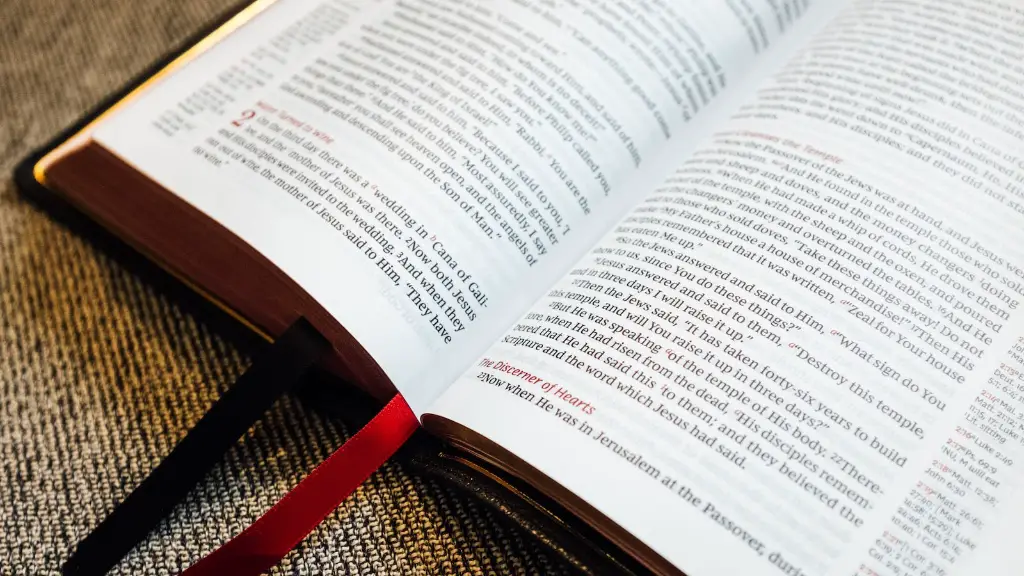The Bible Belt is an area of the United States where church attendance and religious belief are particularly high. This region stretches from east Texas, up through the South and into the Midwest from where it spreads out across the country. It’s one of the most religious regions of the world and has a strong influence on American culture and politics.
The term Bible Belt is credited to journalist H.L. Mencken, who popularized it in the mid 1920s. The area is marked by high church attendance and a strong adherence to traditional religious values. A study conducted by the Barna Group discovered that in this region, the majority of adults agreed with the statement that “The Bible is the actual or Inspired Word of God and we must take it literally”. Evangelical Protestantism is predominant in most southern states, while the Midwest and Plains states represent a more diverse mix of Protestant denominations and Roman Catholicism.
The geography of the Bible Belt is predominantly rural and is characterized by deep religious and cultural identity. This region has a strong, often pervasive, religious presence in day-to-day life, with large churches and small, rural chapels dotting the landscape. Though most of the residents in the region are Christian, minorities represent a substantial portion of the population. The area is also home to a large number of African American, Latino and Native-American churches.
The Bible Belt has long played a major role in American politics, with its influence extending back to the founding of the nation. The region has consistently sent conservative politicians to both state legislatures and to the federal government for generations, making it one of the most politically influential parts of the nation.
The Bible Belt’s influence also extends to the field of education. The region has a long history of strong support for faith-based education, and many private schools in the area are heavily influenced by religious teachings. In states like Mississippi and Alabama, private schools are the main source of education for much of the population.
Economically, this area of the nation is relatively stagnant. Despite its strong religious identity, most states in the region are well below the national median income level. This has had a direct effect on the region’s educational attainment levels, with most states lagging far behind the national average.
The presence of the Bible Belt in American public life is undeniable, and its influence in politics, education and culture is long-standing and powerful. The region’s deep religious identity and traditional values have been a major force in the United States since its founding.
How Has The Bible Belt Been Impacted By The Digital Age?
The Bible Belt has been significantly impacted by the rise of digital technology in the past two decades. As internet access has become increasingly pervasive and influential, religious organizations in the region have adapted to new methods of communication and outreach.
Social media has been a major tool for the spread of religious thought in the Bible Belt. Platforms like Facebook, Twitter and YouTube offer a platform to reach new audiences, while websites like Godtube, a Christian video hosting site, facilitate the free exchange of religious ideas. Churches have also been actively involved in using digital tools, incorporating elements like sermon streaming and online giving into the core operations of the modern church.
Mobile technology is also playing an increasingly important role in the spread of religious thought in the Bible Belt. Apps like BibleLens and YouVersion allow for easy access to the Bible on smartphones, while podcasts and digital sermons give people on-demand access to religious messages and teachings.
The presence of the Bible Belt in the digital age should not be overlooked. Churches and ministries in the region are finding innovative ways to connect with their constituents and spread the good news of the Gospel while still preserving traditional values. The Bible Belt is at the forefront of the digital revolution in the area of religion.
What Social Factors Affect The Bible Belt?
Various social factors have an impact on the religious landscape of the Bible Belt. These factors range from access to education and healthcare to housing affordability.
Access to education is a major factor in the Bible Belt, as many states in the region are home to struggling public school systems with above-average dropout rates. This has a direct impact on religious practices in the area, as children with limited educational opportunities may have difficulty understanding and retaining religious texts.
Access to healthcare and housing affordability are also factors that can have an impact on the population’s religious practices and beliefs. Most states in the Bible Belt have above-average poverty rates, meaning that many individuals may be unable to access regular healthcare or housing. This can lead to an even greater reliance on religious belief and practice.
Finally, the political climate in the region can also have an effect on religious belief. Since the region has consistently sent conservative politicians to both state and federal positions, religious sentiment and values are often reflected in policy decisions. This can often create tension between social and political structure that isn’t found in other parts of the country.
What Impact Has The Bible Belt Had On U.S. Culture?
The Bible Belt has had a major impact on the national culture of the United States. This area of the country has long been a bastion of conservative thought and values, and its influence can be seen in various aspects of the culture.
The region’s religious beliefs have shaped the national discussion surrounding hot-button topics such as abortion and same-sex marriage. Many politicians in this area of the country have pushed for legislation to reflect their conservative religious values. This has had an impact on the national conversation surrounding these issues.
The region’s strong Christian identity has also had an impact on the popular culture of the United States. Music and television programs from the region often contain religious themes, while popular authors such as C.S. Lewis, J.R.R. Tolkien and J.K. Rowling have all drawn inspiration from Christian beliefs.
The Bible Belt’s impact on the United States is undeniable, and its influence in the national culture and politics will likely remain strong for the foreseeable future.
What Role Has The Bible Belt Played In Social Movements?
The Bible Belt has had a major impact on the various social movements that have swept through the United States in the past few decades. In most cases, the region’s religious beliefs have been opposed to the various progressive causes that have sought to move the country forward, particularly on issues such as abortion and same-sex marriage.
The region has also been the source of many of the nation’s most vocal leaders in the social justice arena. Figures such as Martin Luther King, Jr., Dr. Harry Lewis Bailey, Rosa Parks and Fred Shuttlesworth all came from the region and fought for the rights of African Americans. Other figures such as Cesar Chavez and Dolores Huerta fought for the rights of farm workers and immigrants.
The Bible Belt has been a major source of both opposition and progress throughout the nation’s history, and its influence in social movements has been significant. Despite the region’s somewhat mixed legacy, its impact on the nation’s social progress remains undeniable.
What Are The Challenges For The Bible Belt?
The Bible Belt is facing a number of challenges in the present day. The most pressing of these is likely the issue of income inequality, which has been exacerbated by the economic downturn of the past decade.
The region’s median income levels are consistently below the national average, and this has had a major impact on the region’s educational attainment levels as well as its overall economic health. This inequality is compounded by the fact that the region’s religious beliefs often come into conflict with progressive policies that seek to alleviate poverty.
Another challenge facing the Bible Belt is the question of religious freedom. The region’s deep religious identity has long been a source of tension between church and state, and this tension is likely to continue for the foreseeable future.
Finally, the Bible Belt is also facing a challenge when it comes to adapting to the digital age. The region has been slower to embrace digital technology than other parts of the nation, and this has had a direct effect on the region’s economic and educational development.
The Bible Belt is facing a number of challenges today, and the region’s leaders will have to find creative solutions to address these issues if the region is to continue to play an influential role in the national landscape.





